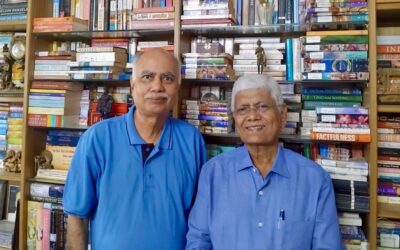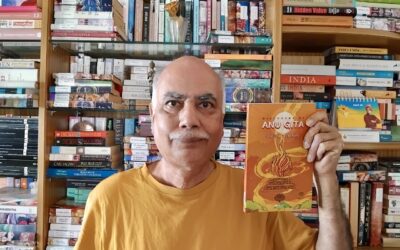Life is a journey, and like in other journeys, we encounter numerous co-travellers — family, friends, mentors, colleagues, and even strangers — who share parts of the path with us. Each co-traveller brings unique experiences, perspectives, and support, enriching our journey in various ways…

Get in touch with your Daemon
Get in touch with your Daemon
Last month, I spent time reading His Dark Materials, by the English author, Philip Pullman. It is a three-book novel comprised of Northern Lights, The Subtle Knife, and The Amber Spyglass. Written as a children’s book, in Harry Potter style, at a superficial level, this book is a fantasy, but presents the most fundamental question – the forces of ‘religion,’ who believe in destiny and present themselves as an intermediary force, versus the free-thinkers, who discard the idea of destiny and allow people to control their own lives. The Northern Lights has been made into films, first, in 2007 and then, in 2019.
Having lived life past youth, settled in a family, and reaching a point in one’s livelihood, every thoughtful person starts realizing that all does not happen as one wishes and that there is an ongoing conflict between what one feels and what one is told, wherever one goes. The axis of all personal struggle is about being in control of every moment of our life. As we grow, we know that the controls we enjoyed are no more effective – things do not happen as per plan, people behave in unpredictable ways, and as old age sets in, and the end point of life is visible, the futility of life stares at us.
My take from the book is that knowledge is fundamental to earn one’s livelihood. Without knowledge, no one can, indeed, survive in the world. The right to decide how one wants to live is given to everyone by God and must never be denied. This right is very desirable. Pullman says that one must operate on one’s knowledge, and live without the grace, comfort and protection of a higher power. Here lies the pivot. I spent a few days in reflection and then realized that there is, indeed, no conflict, confusion, or even dilemma in his statement. All problems arise out of the error in understanding the meaning of knowledge and grace.
The ninth verse of the Ishavasya Upanishad, comprised of just 18 verses, puts it very bluntly:
अन्धन्तमः प्रविशन्ति येऽविद्यामुपासते ।
ततो भूय इव ते तमोय उ विद्यायां रताः ॥
They who live in complete ignorance, fall into blind darkness; and they who live by knowledge alone, fall into an even deeper darkness.
So, it is neither by living in ignorance of what is happening around, nor by its complete knowledge, that life can be understood. The mind must be applied to make sense of the situation you are in, attend to the responsibility and obligations that the situation brings in, but leave the outcome to a higher power, as you are not the only person living in the world – there are 8 billion like you – and as your situation has emerged out of a bigger situation, the solutions also lie beyond you. But the key is to do your part, your bit of what is to be done. Not doing that is sin.
When I watch people living false lives – not studying in one’s student days, not taking care of their physical and mental fitness, not honing the skills required in earning their livelihood, but pretending at work, and not feeling grateful for the gift of life, family and friends that they have already received, I look at these as acts of self-inflicting injury, the splurging of one’s endowments, and becoming a part of the problem for everyone, rather than a part of the solution in their own lives. As time passes, these people’s own colleagues, relatives, and even children desert them, and they spend their last years in despair.
It is unpleasant to look at life in this way. But not to know something, because it hurts, is no escape either. It is here that Pullman’s book offers some brilliant insights. Pullman presents daemons, the external expressions of people’s souls, taking forms that symbolize their owners’ character. Pullman presents them as animal companions present with one from birth till the end of one’s life. They keep changing their forms, depending upon the situation, but their basic form remains unchanged.
Your daemon represents your basic nature, the way you are – your instincts, your drives, your temperament, your likes, and dislikes. Your daemon is your uniqueness. The world we live in is designed to separate us from our daemon and turn us into components of a machine – working where fitted. As we grow, we shun our daemons, but they never die till our own death. Living connected to your daemon, is, therefore, the only way to live a purposeful life. In practical terms, keep your child alive in your heart, be mindful of your emotions, and keep releasing them appropriately.
There is a quiz on the Internet. You answer ten questions, and your daemon is suggested to you. My daemon was a grey wolf. It was written, “Your daemon is mysterious, loyal, strong, and the kind that would do anything for their loved ones. But with that, you have a dangerous side that can frighten your enemies and sometimes even your friends.” I searched for more clues. One site says about people with a grey wolf daemon, “You are self-motivated and ambitious. Once you have an idea in your head there is little that can stop you on your road to success. You don’t let yourself get pushed around and you won’t stop until you’ve achieved your goals.”
Had my daemon been a peacock, a lion, or even an elephant, I would have been delighted, perhaps. But a wolf? It took me a while to digest this. But as I recollected my experiences, starting from early childhood, University, the DRDO, the Care Hospital, my time with President Kalam and after him, my health, friendships, fights, and health issues… the grey wolf looked more and more reasonable.
I certainly enjoyed cooperative game hunting to achieve recognition; I was quick to adapt where I was; I tackled difficult people diplomatically, rather than going in for direct fights, which I was sure I would lose; I had a good social nature and very expressive behavior, no different from individual or group howling. I travelled with my wife and children, prioritizing these trips over other expenses. But the Aha! moment came when I realized that a wolf is the ancestor of the domestic dog.
And then, many characters flooded my memories, who flourished in their careers by following the commands their bosses gave them – right or wrong was never their concern. They did what they were told to and felt happy with whenever and whatever they got. But I could not do that. I remain a little bit of a wild animal in this world, never fully domesticated, and in the process, perhaps, not as rewarded as others.
So, know your daemon. And then keep him close to your heart in whatever you do. Let your daemon talk to you. Drift, wait, and obey, if you like, but hear him, nevertheless. As Philip Pullman writes about multiverses, this world is just one place, a little aspect of the One, which exists in a million forms, at a million places, even at this very moment. Your daemon is your bridge into those unseen realms and helps you meet your doppelgänger – your double i.e., your true nature, like a mirror!
MORE FROM THE BLOG
A Life of Service is a Life Lived Well
The Utility and Futility of a Human Life
I am running into my seventieth year. Born on February 10, 1955, I have lived a somewhat uncertain life with some cardiac electrophysiological issues since childhood and, later, coronary artery disease that necessitated multiple angioplasties, a bypass surgery, and two stents…
The Secret of Life
Who I am? Why was I born? Why are people born in different conditions – some in poor families, some in rich, some in developed countries, some in conflict-prone areas and amidst astute poverty and depravity?…









